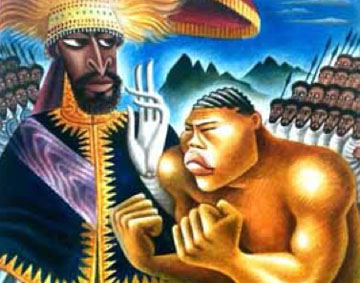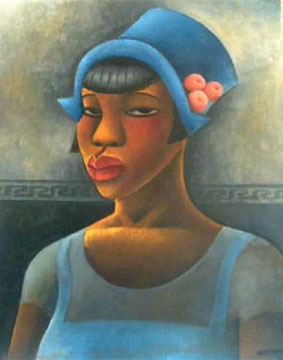 For people that cannot afford to travel to another country anytime soon, visiting “The African Diaspora in the Art of Miguel Covarrubias Driven By Color, Shaped By Culture'” exhibit at the California African American Museum (CAAM) is the next best thing. With five sections divided by geographic region from the Caribbean to Mexico, the retrospective has an international feel and hums with vibrancy from each culture.
For people that cannot afford to travel to another country anytime soon, visiting “The African Diaspora in the Art of Miguel Covarrubias Driven By Color, Shaped By Culture'” exhibit at the California African American Museum (CAAM) is the next best thing. With five sections divided by geographic region from the Caribbean to Mexico, the retrospective has an international feel and hums with vibrancy from each culture.
The African diaspora is defined as the movement of Africans and their descendants throughout the world. This exhibit strives to highlight the links and commonalities of African descent around the world through the artist’s work, although some geographic regions are better represented than others.
The Harlem Renaissance gallery has the most layers with jazz music wafting from a speaker hung above, and the breadth of the portraits there are the most fascinating. With titles like “Harlem Dandy,” Harlem Beauty” and “Harlem Matron,” the portraits could easily be dismissed as caricatures of African Americans. But Covarrubias demonstrates a curiosity that goes beyond the surface of these characters, hinting at their personalities and stories.
 Covarrubias’ line drawings are economical yet effective in expressing a certain swagger or attitude with just a few strokes. A woman in a flapper hat rests her hand on her hip with a jaded stare emanating a casual nonchalance. In another work, a young man has his hat tilted over his eyes conveying a cool, laidback demeanor. In works such as “The Lindy Hop” and “Percussion,” the artist captures dance, movement and music with a sense of raw immediacy.
Covarrubias’ line drawings are economical yet effective in expressing a certain swagger or attitude with just a few strokes. A woman in a flapper hat rests her hand on her hip with a jaded stare emanating a casual nonchalance. In another work, a young man has his hat tilted over his eyes conveying a cool, laidback demeanor. In works such as “The Lindy Hop” and “Percussion,” the artist captures dance, movement and music with a sense of raw immediacy.
Covarrubias gained recognition for having his illustrations and drawings featured on the cover of magazines such as Life, Vanity Fair and Vogue. He was also known as a theater set and costume designer, and worked on Josephine Baker’s “La Revue Negre.”
He also created a series of illustrations for a limited edition of Uncle Tom’s Cabin” and Zora Neale Hurston’s “Mules and Men.” Displaying the physical copies of the magazine and books provides context for the work and lets the viewer experience his work in the way that most people did – through mass media and print publications.
The Mexico and Caribbean galleries did not feel as full and rich as the other galleries, with the Caribbean works echoing the fascination with rhythm and movement in his depictions of the Rumba dance. In the Africa display, Covarrubias explores the marriage of dance and ritual along with traditional African costumes rich in detail.
 The last gallery for the Pageant of the Pacific finishes the show strong, with a large mural of the Pacific and its different islands and peoples on a great expanse of wall. Surrounding the large map are six smaller murals each depicting different characteristics of the Pacific. Covarrubias style is more cartoonish and stylized but matches the humorous and playful tone of the symbols and pictures on the maps. For example, a drawing of a blonde bikini clad starlet symbolizes the industry in Southern California on the “Economies” map. The other maps illustrate flora and fauna, peoples, art forms, native means of transportation and native dwellings of the Pacific.
The last gallery for the Pageant of the Pacific finishes the show strong, with a large mural of the Pacific and its different islands and peoples on a great expanse of wall. Surrounding the large map are six smaller murals each depicting different characteristics of the Pacific. Covarrubias style is more cartoonish and stylized but matches the humorous and playful tone of the symbols and pictures on the maps. For example, a drawing of a blonde bikini clad starlet symbolizes the industry in Southern California on the “Economies” map. The other maps illustrate flora and fauna, peoples, art forms, native means of transportation and native dwellings of the Pacific.
African Diaspora” is exactly what an exhibit about migration and cultural exchange should be – experiencing new cultures, interesting people and exploring the unfamiliar or even the familiar but with a fresh perspective.
The exhibit, which took three years to complete and includes several pieces that haven’t been seen in the U.S., is currently on view at the the California African American Museum until February 26, 2012.
You can read more about the exhibit and the artist here.










 Some of the most compelling pieces were by David Hammons, a multimedia artist that went on to win the MacArthur Fellowship (also known as the “Genius Grant”) in 1991.
Some of the most compelling pieces were by David Hammons, a multimedia artist that went on to win the MacArthur Fellowship (also known as the “Genius Grant”) in 1991. 




